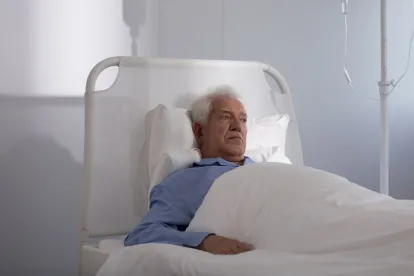A Discussion of the Patient Safety Work Product Privilege
Richard Rumsey underwent an elective hospital procedure at Robert Packer Hospital (“Hospital”).1 After he developed an infection, Mr. Rumsey sued the Hospital for medical malpractice and sought information related to the Hospital’s infection prevention guidelines.2 A Pennsylvania federal court determined Mr. Rumsey could not access most of the requested documents because such documents fell within the federal Patient Safety and Quality Improvement Act (“PSQIA”) Patient Safety Work Product privilege.3
Patient Safety Work Product Privilege Under Federal Law
The Patient Safety Work Product Privilege is derived from PSQIA and its implementing Patient Safety Rule.4 The court described the Patient Safety Work Product Privilege as “intended to promote candor in patient safety evaluations from clinicians who may otherwise mince their words out of fear of malpractice litigation.”5 PSQIA’s intention is to provide for frank discussion of patient safety activities without fear that such discussion will later be used against the health care entity in litigation.6 Pennsylvania’s state law, the Medical Care Availability and Reduction of Error Act (“MCARE”), provides similar protections.
The privilege applies to Patient Safety Work Product (“PSWP”) as defined under PSQIA. Arguably, the privilege applies to PSWP as defined under the Patient Safety Rule as follows:
"any data, reports, records, memoranda, analyses (such as root cause analyses), or written or oral statements (or copies of any of this material)
(i) [w]hich could improve patient safety, health care quality, or health care outcomes; and
(A) [w]hich are assembled or developed by a provider for reporting to a [patient safety organization or] PSO and are reported to a PSO, which includes information that is documented as within a patient safety evaluation system for reporting to a PSO, and such documentation includes the date the information entered the patient safety evaluation system; or (B) [a]re developed by a PSO for the conduct of patient safety activities; or
ii) [w]hich identify or constitute the deliberations or analysis of, or identify the fact of reporting pursuant to, a patient safety evaluation system.7
PSQIA and the Patient Safety Rule clarify that PSWP does not include information that is collected, maintained, or developed separately, or exists separately, from a patient safety evaluation system.8 While information in the patient safety evaluation system and in the patient safety organization may be PSWP, copies of such information outside of the patient safety evaluation system or the patient safety organization are not considered PSWP and are not protected.9
Patient Sought Hospital Documents Regarding Infection Controls and Protocols Under Three Categories
Specifically, Mr. Rumsey sought:
(1) a copy of all infection prevention and infection control materials which the Hospital received prior to May 1, 2017 from its patient safety organization or other company (“Category 1”);
(2) copies of the Hospital’s agendas, notes and any and all other written records of Hospital’s quality committee meetings from May 1, 2016 to May 1, 2017, that discuss infection prevention or infection control (“Category 2”); and
(3) a copy of any and all correspondence and communications between the Hospital and any governmental agency within the past 5 years on the subject of infection prevention, infection reporting, infection management and infection rates (“Category 3”).
The court ruled on each of these requests.
1. Hospital’s Infection Prevention and Control Materials Protected as PSWP
Regarding Category 1, the request for the Hospital’s infection prevention and infection control materials, the court found that state law did not apply, but the requested documents fell under PSQIA’s definition—documents that are produced by the patient safety organization for the purpose of conducting patient safety activities. As such, the documents were protected by the PSWP privilege and not ordered produced to the patient.
2. Hospital’s Meeting Notes Regarding Infection Control Protected as PSWP
For Category 2, the request for the Hospital’s agendas, notes and any and all other written records of Hospital’s quality committee meetings discussing infection prevention or infection control, the court called such records the “quintessential example of patient safety work product privilege.”10 The court determined that “agendas, notes, and other written records from these meetings are squarely work product and are ‘deliberations or analysis of’ a patient safety evaluation system. These are protected under PSQIA and the MCARE Act, as well as Pennsylvania’s Peer Review Protection Act.”11 As with Category 1, the patient did not receive the requested documents.
3. Hospital’s Communications to Government Agencies Not Protected as PSWP
When considering Category 3, the request for the past five years of correspondence between the Hospital and any governmental agency regarding infection prevention, infection reporting, infection management and infection rates, the court determined such communications are not “work product.” The court noted communications with government agencies are not part of the Hospital’s patient-safety evaluation program or its process of disclosing peer-review information to its patient safety organizations, and such correspondence would not have been generated for the purpose of reporting.12 Thus, such communications were not privileged; though the court limited the relevant time period from five years to only two years.13
PSWP Privilege is a “Quiet Corner of the Room, Not a Private Island”
The court described the Patient Safety Work Product Privilege as “a quiet corner of the room, not a private island.”14 Through this privilege, medical professionals may provide frank and honest feedback to assist with patient safety, while protecting such discussions from being used against the medical professionals in litigation, as long as such discussion “remains within the confines of the patient safety evaluation system.”15
1 Rumsey v. Guthrie Med. Group, P.C., 4:18-CV-01605, 2019 WL 4687560, at *1 (M.D. Pa. Sept. 26, 2019).
2 Id. at *1.
3 Id. at *3.
4 See 42 C.F.R. § 3.10 et seq.
5 Id. at *1.
6 Rumsey, 2019 WL 4687560, at *4.
7 45 C.F.R. § 3.20.; 42 USC § 299b-21(7)(A).
8 42 USC § 299b-21(7)(B).
9See Id.
10 Rumsey, 2019 WL 4687560, at *3.
11 Id.
12 Id.
13 Id. at *3.
14 Rumsey, 2019 WL 4687560, at *4.
15 Id.





 />i
/>i

